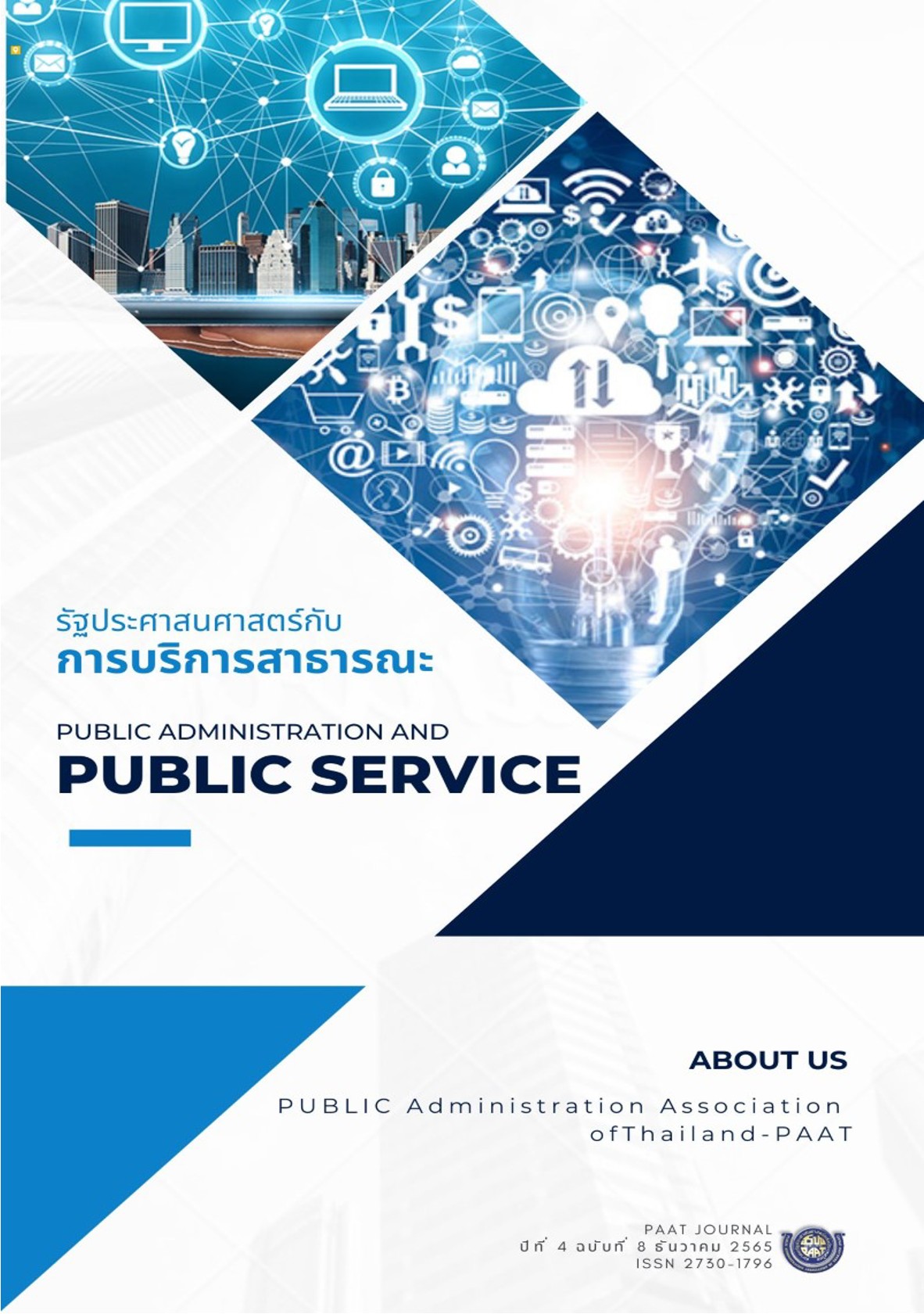การปรับตัวในการบริหารจัดการทรัพยากรมนุษย์ขององค์การไม่แสวงหาผลกำไร ในยุควิถีใหม่
คำสำคัญ:
การบริหารจัดการทรัพยากรมนุษย์, การจัดการองค์การไม่แสวงหากำไร, การบริหารจัดการทรัพยากรมนุษย์ในองค์การไม่แสวงหากำไร, ทุนมนุษย์, ภาคประชาสังคมบทคัดย่อ
สถานการณ์การระบาดของโรคติดเชื้อไวรัสโคโรนาสายพันธุ์ใหม่ 2019 (Covid-19) ส่งผลกระทบทั้งต่อวิถีในการดำเนินชีวิตของประชาชนในสังคม รวมถึงในแง่ของการบริหารจัดการองค์การในทุกภาคส่วนซึ่งจำเป็นจะต้องปรับตัวเข้ากับความเปลี่ยนแปลงของสภาพการณ์ซึ่งมีความผันผวนสูง องค์การที่ไม่แสวงหาผลกำไรและภาคประชาสังคม ถือเป็นกลไกในการขับเคลื่อนสังคมเพื่อบรรลุเป้าหมายในการพัฒนาอย่างยั่งยืน โดยภาคส่วนนี้มีคุณลักษณะเฉพาะหลายประการ โดยเฉพาะในแง่ของความสามารถในการแสวงหารายได้และการพึ่งพาตนเองทางการเงิน รวมถึงด้านองค์ประกอบของแรงงานอาสาสมัครอันเป็นทุนมนุษย์ที่มีความสำคัญในการขับเคลื่อนพันธกิจขององค์การประเภทนี้ ซึ่งจำเป็นต้องปรับตัวเพื่อตอบสนองต่อความเปลี่ยนแปลง หนึ่งในมิติที่สำคัญเป็นอย่างยิ่ง คือการบริหารจัดการทรัพยากรมนุษย์ในองค์การไม่แสวงหาผลกำไร อาทิ ความต่อเนื่องของภาวะผู้นำ การรักษาแรงจูงใจในการให้บริการสาธารณะ รวมถึงคุณลักษณะของแรงงานในภาคส่วนนี้ซึ่งทวีความหลากหลายและเกิดช่องว่างระหว่างช่วงวัยมากขึ้น ข้อเสนอแนะและแนวทางในการปรับตัวเพื่อปรับเปลี่ยนกลยุทธ์ในการจัดการทุนมนุษย์เพื่อรักษาประสิทธิภาพในการบริหารจัดการและตอบสนองต่อความพลิกผันในยุควิถีใหม่ คือ การปรับโครงสร้างองค์การให้มีลักษณะแบนราบและยืดหยุ่น มุ่งเน้นการปฏิบัติงานโดยเน้นที่ผลลัพธ์ของงานเพื่อบรรลุเป้าหมายและพันธกิจ พนักงานจะต้องเรียนรู้อย่างต่อเนื่องเพื่อพัฒนาทักษะและสมรรถนะต่างๆให้ทันการเปลี่ยนแปลง เช่น ความรู้เท่าทันด้านดิจิทัล ความรู้เท่าทันระหว่างช่วงวัย ซึ่งจะช่วยทำให้พนักงานสามารถใช้ประโยชน์จากเทคโนโลยีได้อย่างมีประสิทธิภาพเพื่อตอบโจทย์รูปแบบการทำงานในยุควิถีใหม่ นอกจากนั้นพนักงานในองค์การควรจะได้รับการส่งเสริมให้พัฒนาและรักษาระดับของการมีปฏิสัมพันธ์ เพื่อถ่ายทอดความรู้และสร้างความร่วมมือระหว่างกัน บทความนี้ชี้ให้เห็นถึงประโยชน์ในการประยุกต์องค์ความรู้ด้านการบริหารจัดการทรัพยากรมนุษย์ ที่คำนึงถึงบริบทเฉพาะของภาคส่วนนี้ ในยุคที่การปรับตัวเพื่อสนองตอบต่อปัจจัยแวดล้อมที่เปลี่ยนแปลงอย่างรวดเร็ว โดยเฉพาะการประยุกต์และบูรณาการแนวคิดด้านการบริหารจัดการคนเก่งและการสร้างความต่อเนื่องในภาวะการนำขององค์การไม่แสวงหากำไรที่มุ่งเน้นเป้าหมายในการให้บริการแก่ประชาสังคมอย่างยั่งยืน
เอกสารอ้างอิง
Akingbola, K. (2013). A model of strategic nonprofit human resource management. Voluntas: International Journal of Voluntary and Nonprofit Organizations, 24(1), 214-240.
Akinlade, D., & Shalack, R. (2017). Strategic human resource management in nonprofit organizations: A case for mission-driven human resource practices. Global Journal of Management and Marketing, 1(1), 121-146.
Armstrong, M. (2016). Armstrong's handbook of management and leadership for HR: Developing effective people skills for better leadership and management. Kogan Page Publishers.
Beechler, S., & Woodward, I. C. (2009). The global “war for talent.” Journal of International Management, 15, 273-285.
Bethke-Langenegger, P., Mahler, P., & Staffelbach, B. (2011). Effectiveness of talent management strategies. European Journal of International Management, 5, 524-539.
Blass, E., & April, K. (2008). Developing talent for tomorrow. Develop, 1(1), 48-58.
Boudreau, J. W., & Ramstad, P. M. (2005). Talentship, talent segmentation, and sustainability: A new HR decision science paradigm for a new strategy definition. Human Resource Management, 44, 129-136.
Call, M. L., Nyberg, A. J., & Thatcher, S. M. (2015). Stargazing: An integrative conceptual review, theoretical reconciliation, and extension for star employee research. Journal of Applied Psychology, 100(3), 623-640.
Cappelli, P. (2008). Talent management for the twenty-first century. Harvard Business Review, 86(3), 74-81.
Charan, R., Drotter, S. J., & Noel, J. L. (2001). The leadership pipeline: How to build the leadership-powered company. Jossey-Bass.
Choi, N. G., & Chou, R. J. A. (2010). Time and money volunteering among older adults: the relationship between past and current volunteering and correlates of change and stability. Aging & Society, 30(4), 559-581.
Collings, D. G., & Mellahi, K. (2009). Strategic talent management: A review and research agenda. Human Resource Management Review, 19, 304-313.
Collings, D. G., Mellahi, K., & Cascio, W. F. (Eds.). (2017). The Oxford handbook of talent management. Oxford University Press.
Cunningham, I. (2005). Struggling to care: Employee attitudes to work at the sharp end of service provision in the voluntary sector. In 23rd Annual Labour Process Conference, Glasgow, April.
Ford, J., Harding, N., & Stoyanova Russell, D. (2010). Talent management and development: An overview of current theory and practice.
Bradford University. Guo, C., Brown, W. A., Ashcraft, R. F., Yoshioka, C. F., & Dong, H. K. D. (2011). Strategic human resources management in nonprofit organizations. Review of Public Personnel Administration, 31(3), 248-269.
Kehoe, R. R., Lepak, D. P., & Bentley, F. S. (2016). Let’s call a star a star: Task performance, external status, and exceptional contributors in organizations. Journal of Management, 44(5), 1848-1872.
Hausknecht, J. P. (2017). Talent and turnover. In D. G. Collings, K. Mellahi, & W. F. Cascio (Eds.), The Oxford handbook of talent management (pp. 361-374). United Kingdom: Oxford University Press.
Hills, A. (2009). Succession planning–or smart talent management? Industrial and commercial Training, 41(1), 3-8.
Kaliannan, M., Darmalinggam, D., Dorasamy, M., & Abraham, M. (2022). Inclusive talent development as a key talent management approach: A systematic literature review. Human Resource Management Review, 33(1), 1-23.
Kim, Y. (2017). Succession planning and management in nonprofit organizations. In The Nonprofit Human Resource Management Handbook (pp. 101-121). Routledge.
Light, P. (2002). The content of their character: The state of the nonprofit workforce. Nonprofit Quarterly.
Lipsky, M. (2010). Street-level bureaucracy: Dilemmas of the individual in public service. Russell Sage Foundation.
O’Boyle, E., & Kroska, S. (2017). Star performers. In D. G. Collings, K. Mellahi, & W. F. Cascio (Eds.), The Oxford handbook of talent management (pp. 43-65). United Kingdom: Oxford University Press.
Perry, J. L. (1997). Antecedents of public service motivation. Journal of public administration research and theory, 7(2), 181-197.
Rothwell, W. (2010). Effective succession planning: Ensuring leadership continuity and building talent from within. Amacom.
Russell, A. R., Walk, M., & Handy, F. (2020). Nonprofit human resource management. In The Routledge companion to nonprofit management (pp. 263-277). Routledge.
Theuvsen, L. (2004). Doing better while doing good: Motivational aspects of pay-for performance effectiveness in nonprofit organizations. Voluntas: International Journal of Voluntary and Nonprofit Organizations, 15(2), 117-136.
Whelan, E., Collings, D. G. & Donnnellan, B. (2010). Managing talent in knowledge-intensive settings. Journal of Knowledge Management, 14(3), 486-504.
Word, J., & Park, S. M. (2009). Working across the divide: Job involvement in the public and non-profit sectors. Review of Public Personnel Administration, 29(2), 103-133.
Word, J., & Park, S. M. (2015). The new public service? Empirical research on job choice motivation in the nonprofit sector. Personnel Review, 44(1), 91-118.
ดาวน์โหลด
เผยแพร่แล้ว
เวอร์ชัน
- 2023-03-03 (3)
- 2023-03-02 (2)
- 2023-02-27 (1)
รูปแบบการอ้างอิง
ฉบับ
ประเภทบทความ
สัญญาอนุญาต
ลิขสิทธิ์ (c) 2023 วารสารสมาคมรัฐประศาสนศาสตร์แห่งประเทศไทย

อนุญาตภายใต้เงื่อนไข Creative Commons Attribution-NonCommercial-NoDerivatives 4.0 International License.



